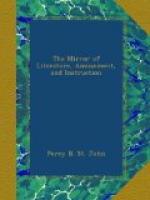[5] James the First.
The celebrated John Hampden represented this borough in five parliaments.
P.T.W.
* * * * *
MANNERS & CUSTOMS OF ALL NATIONS.
* * * * *
HIPPODROME GAMES.
(For the Mirror.)
The Olympian Hippodrome, or horse-course, was a space of ground of six hundred paces long, surrounded with a wall, near the city of Elis, and on the banks of the river Alpheus. It was uneven, and in some degree irregular, on account of the situation;—in one part was a hill of moderate height; and the circuit was adorned with temples, altars, and other embellishments. There was a very famous hippodrome at Constantinople, which was begun by Alexander Severus, and finished by Constantine. This circus, called by the Turks atmeican, is four hundred paces long, and above one hundred paces wide. At the entrance of the hippodrome there is a pyramidical obelisk of granite, in one piece, about fifty feet high, terminating in a point, and charged with hieroglyphics. The Greek and Latin inscriptions on its base show that it was erected by Theodosius. The machines that were employed to raise it are represented upon it in basso-relievo. We have some vestiges in England of the hippodromus, in which the ancient inhabitants of this country performed their races. The most remarkable is that near Stonehenge, which is a long tract of ground, about three hundred and fifty feet, or two hundred Druid cubits wide, and more than a mile and three quarters, or six thousand Druid cubits in length, enclosed quite round with a bank of earth, extending directly east and west. The goal and career are at the east end. The goal is a high bank of earth, raised with a slope inwards, on which the judges are supposed to have sat. The metae are two tumuli, or small barrows, at the west end of the course. These hippodromes were called, in the language of the country, rhedagua; the racer, rhedagwr; and the carriage, rheda—from the British word rhedeg, to run.
One of these hippodromes, about half a mile to the southward of Leicester, retains evident traces of the old name, rhedagua in the corrupted one of Rawdikes. “There is another of these,” says Dr. Stukely, “near Dorchester; and another on the banks of the river Lowther, near Penrith, in Cumberland; and another in the valley just without the town of Royston.”




